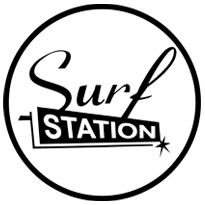Your Cart is Empty
SURF REPORT
Learn To Surf - The Complete Guide
by Antonio Berrocal May 02, 2017 3 min read
There is nothing like gliding down the face of a wave. And when you learn to position yourself so the wave pitches over locking you inside, it is the most exhilarating feeling in sports.
Now, very few of us are going to be tubed on the first day. This article is about learning to surf, the basics in choosing a surfboard, and how to get started.

Surfing is one of the few sports that you are having as much fun learning as even the experts do. When in the water catching waves, that very first wave is super fun, five years later it's fun, and 30 years later it's still fun! So although there is a learning curve to surfing, it is a super fun learning curve. When learning to surf you want to start out on a wider than normal surfboard. Nothing narrower than 19" and the wider over 20", the better. The length of the board matters too. A longer surfboard allows added stability. 2 feet over your head, or larger. So a 6 foot person needs at least and 8 foot surfboard. Yes you can learn on a shorter board, but the shorter you go, the less stable it is, and therefor harder to learn on. To better understands this, imagine it like standing in a canoe, if you get a very narrow canoe, it is tippy and hard to keep your balance. But a very wide canoe is stable and easy to keep your balance. The same with surfing, a wider surfboard is more stable. Construction of your surfboard: fiberglass, epoxy, foam? What is best to learn on? If you are timid, accident prone, or just want the very safest way to learn, then start out on a foam surfboard. This way, if the board springs back and hits you, you are way less likely to get hurt. Many parents start their kids out on a foamy. Most surf schools start beginners out on foam surfboards. We have a wide variety of foam boards, in all sizes, check them out here. If you already have the basics down and want to go faster, a fiberglass or epoxy surfboard is much better, offering more performance. Fiberglass is the standard in surfing and has that classic feel when riding the wave. It is by far the most popular. When learning, make sure you pick one wide and full! Here is a link to some excellent low cost fiberglass boards. Epoxy is lighter, stronger, and offers more buoyancy. It is 'lively' in the water and is very good in small waves and a good choice for beginners. Here is a link to some good epoxy surfboards we carry here at the Surf Station.  Once you learn, go shorter! A shorter board has a shorter turning radius so is therefore more maneuverable. Turning and carving your surfboard on the wave is fun! Shorter boards help with this. Here at the Surf Station we want to help you get to the point of riding performance surfboards and ripping. One way to get started is in our surf school. Here is a link for more information on learning to surf: http://www.surf-station.com/learn-how-to-surf/ Hopefully this article helps you to get started. If you have questions or need additional help please write us at support@surf-station.com We also offer 'live help' where our staff can direct and assist you in picking out the perfect surfboard and more. Click on the Live Help button on our website here and we will get you started!
Once you learn, go shorter! A shorter board has a shorter turning radius so is therefore more maneuverable. Turning and carving your surfboard on the wave is fun! Shorter boards help with this. Here at the Surf Station we want to help you get to the point of riding performance surfboards and ripping. One way to get started is in our surf school. Here is a link for more information on learning to surf: http://www.surf-station.com/learn-how-to-surf/ Hopefully this article helps you to get started. If you have questions or need additional help please write us at support@surf-station.com We also offer 'live help' where our staff can direct and assist you in picking out the perfect surfboard and more. Click on the Live Help button on our website here and we will get you started!
4 Responses
Monty
December 31, 2017
Im 65 and surf 2-3 day a week. I have been surfing since I was 12 years old. Unless you have some debilitating physical ailment there is no age to old to learn. This sport will keep you young!!!
Juan Castro
September 06, 2017
I am 59 and been surfing for 2 years. And it’s a BLAST! I do recommend taking lessons, it is worth it.
will crow
July 16, 2017
just wondering if 50 is too old to learn how to surf? I’d like to learn this winter and am looking for a surf camp type of place to go. Thanks. Will Crow
Leave a comment
Comments will be approved before showing up.


Tory
January 10, 2018
It’s never too old to learn to surf! Here is a great place to learn, right here in St. Augustine: http://www.surf-station.com/learn-how-to-surf/ They are open 7 days a week and give great surf lessons! -Tory